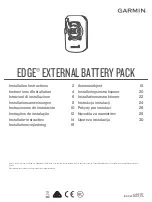
3
EN
CZ
IT
R
O
РУ
TR
A
pp
en
dix
3. OPERATION
3.1 On/Off Push button
When switched to "on" with the pushbutton, the product is fully functional. The inverter will come into operation and the LED "inverter"
will light up. By pushing the push button subsequently, within a short period of time, the inverter toggles between “on”, “ECO” and “off”.
The inverter goes into sleep mode with minimal current consumption when the unit is turned off by the pushbutton.
Apart from the pushbutton; the inverter can also be switched on (normal or ECO) and off with Bluetooth on a mobile device running iOS
or Android and the VictronConnect app. However when switched off via Bluetooth or the push button; the unit cannot be switched on
and off again via the wired VE.Direct port.
On/Off Switch (5kVA only)
The 5kVA unit has a main on/off switch next to the cable entries on the right side. This switch; when turned off, will cut off the supply
current completely.
3.2 Remote control
Remote control is possible with a simple on/off switch or with a Phoenix Inverter Control panel. A switch for remote control (on/off) can
be connected to a two pole connector. The switch can also be connected between battery plus and the left hand contact of the two pole
connector (marked “H”; see appendix A) or between battery minus and the right hand contact of the two pole connector (marked “L”; see
appendix A).
For safety purposes, this product can be turned off completely (i.e. the
inverter cannot be switched on via the push button or Bluetooth) by
removing the remote connector and its default installed wire bridge (or
swtich off the remote on/off switch if installed). The user can then be
certain that the inverter cannot be switched on accidently via Bluetooth
by an unexpected other user.
3.3 LED definitions
Green LED
Status
Trouble shooting
●●●●●●●●
Inverter on
Red LED Off
status OK
Red LED On or blinking:
The Inverter is still on, but will shut down when the condition gets worse. See red LED table for warning reason
●●
------
ECO mode
If the inverter keeps switching on and off while there is a load connected, the load may be too small compared
to the actual ECO mode settings. Increase the load or change ECO mode settings. (minimum ECO mode setting:
15W)
●
-
●
-----
Off and waiting
Inverter did shut down because of a protection. The inverter will restart automatically as soon as all alarm
conditions are cleared. See red LED state for the shutdown reason.
--------
Inverter off
Red LED Off
Check Remote on/off connector.
Check DC cable connections and fuses.
Check operational mode by pushing push button one time.
Red LED On or blinking
The inverter did shut down because of a protection. It will no longer automatically restart. The red LED indicates
the reason for shutdown. Remove the cause and then restart the inverter by switching it Off, and then back On.
●
-
●
-
●
-
●
-
Off and frirmware update in
progress or failed
Red LED Blinking (
-
●
-
●
-
●
-
●
)
Firmware update in progress or firmware update failed. When failed; retry firmware update.
Yellow LED
Status
Trouble shooting
●●●●●●●●
ECO mode
Red LED Off
status OK
Red LED On or blinking:
The Inverter is still on, but will shut down when the condition gets worse. See red LED table for warning reason
--------
ECO mode off
Red LED Off
Check operational mode by pushing push button one time.
Check Remote on/off connector.
Check DC cable connections and fuses.
Red LED On or blinking
The inverter did shut down because of a protection. It will no longer automatically restart. The red LED indicates
the reason for shutdown. Remove the cause and then restart the inverter by switching it Off, and then back On.
Red LED
Definition
Trouble shooting
●●●●●●●●
Solid on
Overload
Reduce load
●●●●
----
Slow blink
Low batt.
Recharge or replace battery
Check DC cable connections
Check cable cross section as it may be insufficient.
See section 4.2 Protections and automatic restarts for manual and automatic
restart behavior.
●
-
●
-
●
-
●
-
Fast blink
High batt.
Reduce DC input voltage, check for faulty charger
●
-
●
-----
Double pulse
High temp.
Reduce load and/or move inverter to better ventilated area
●
---
●
---
Fast single pulse
High DC ripple
Check DC cable connections and cable cross section.






































